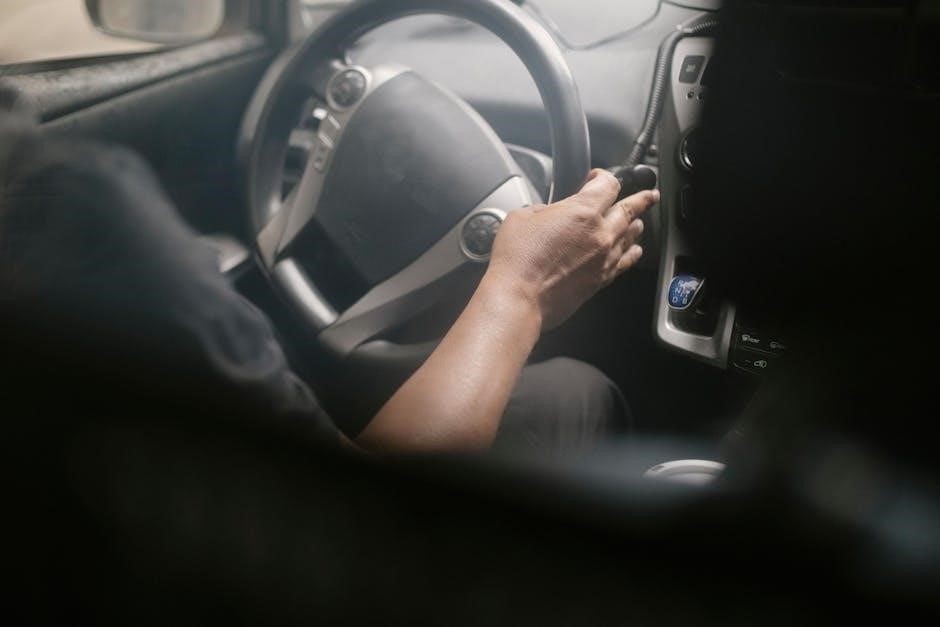Viper Car Alarm Manual: A Comprehensive Guide
Welcome to your comprehensive guide to Viper car alarm manuals! Viper is a popular brand known for its advanced security features and user-friendly remote start systems. This guide is designed to assist you in navigating the essential aspects of your Viper alarm system.
Viper car alarms are renowned as a leading solution in vehicle security and remote start technology. With a legacy built on cutting-edge innovation, Viper provides a comprehensive range of systems designed to protect your vehicle and offer convenient features. These systems often include keyless entry, allowing you to lock and unlock your car doors effortlessly.
Whether you’ve recently purchased a used car with a pre-installed Viper alarm or are looking to upgrade your current security setup, understanding the fundamentals of Viper car alarms is crucial. This section will introduce you to the core components, functionalities, and benefits of Viper systems, helping you make the most of your investment.
From basic arming and disarming procedures to advanced programming options and troubleshooting tips, this guide will serve as your go-to resource for all things Viper. With Viper, you can count on security and features that put you in control.
Finding Your Specific Viper Model Manual
Locating the correct manual for your specific Viper car alarm model is the first crucial step in understanding and effectively using your system. Viper offers a wide range of models, each with its unique features and functionalities, so having the right manual ensures you have accurate information.
If you have the original packaging, the model number is often printed on the box. If not, check the control module, typically located under the dashboard; although the model number may not always be visible. For used cars with pre-installed systems, identifying the model might require contacting a professional installer or Viper’s tech support.
Once you’ve identified the model, visit the Directed Electronics website, the company behind Viper, or ManualsOnline for a comprehensive collection of user guides and installation manuals. These resources provide free PDF downloads of various Viper manuals. Having your specific model manual on hand will greatly enhance your ability to troubleshoot issues, customize settings, and fully utilize your Viper car alarm system.

Understanding Viper Alarm System Components
To effectively use and troubleshoot your Viper car alarm system, it’s essential to understand its primary components. These components work together to provide comprehensive vehicle security and remote start capabilities. The main components include the control module, which is the brain of the system, processing signals and managing various functions.
Next, you’ll find the siren, which emits audible alerts to deter theft and notify you of potential threats. Then there are the door, hood, and trunk sensors, which detect unauthorized entry. The system also includes a remote control, which allows you to arm, disarm, and control other features remotely.
Many Viper systems feature a shock sensor that detects impacts to the vehicle, triggering the alarm. Some advanced models incorporate GPS tracking for enhanced security and vehicle location.
Understanding these components and their roles will enable you to better diagnose issues, perform maintenance, and optimize your Viper alarm system for maximum protection and convenience.
Basic Operation: Arming and Disarming
The fundamental operations of a Viper car alarm system involve arming and disarming the system, ensuring your vehicle is protected when unattended and accessible when needed. Arming the system typically involves pressing the lock button on your Viper remote. Upon pressing the lock button, the system will engage, locking the doors and activating the alarm sensors. You’ll usually hear a chirp or see the parking lights flash to confirm that the system is armed.
Disarming the system is usually accomplished by pressing the unlock button on your remote. This disengages the alarm, unlocks the doors, and allows you to enter and start your vehicle. Like arming, disarming is often confirmed with a chirp or flashing lights.
Some Viper systems offer silent arming and disarming modes, where the audible confirmation is disabled to avoid disturbing others.
Understanding these basic operations is crucial for the day-to-day use of your Viper alarm system, providing peace of mind and convenient control over your vehicle’s security.
Key Features and Functions Explained
Viper car alarms boast a range of features designed to enhance vehicle security and convenience. One key function is remote start, which allows you to start your car from a distance, ideal for warming it up in cold weather or cooling it down on hot days.
Another common feature is keyless entry, enabling you to lock and unlock your car doors without a physical key. Many Viper systems include shock sensors that trigger the alarm if the vehicle is bumped or jostled, providing an additional layer of protection against theft.
Some models also offer tilt sensors, which detect if the vehicle is being lifted, such as during a towing attempt, and will activate the alarm. Furthermore, Viper alarms often have a panic mode, which can be activated by pressing a button on the remote to sound the alarm and attract attention in an emergency.
Understanding these features is essential for maximizing the benefits of your Viper alarm system.
Troubleshooting Common Issues
Encountering issues with your Viper car alarm can be frustrating, but many problems can be resolved with simple troubleshooting steps. One common issue is a malfunctioning remote. Ensure the battery is not depleted and try re-syncing the remote with the system, following the manual’s instructions.
If the alarm frequently triggers for no apparent reason, sensitivity settings might need adjustment. Refer to the manual to lower the shock sensor sensitivity. Another problem is the alarm not disarming, which could be due to a faulty door trigger.
Check the door pins and wiring for any damage or loose connections. If the remote start isn’t working, verify that all safety requirements are met, such as the hood being closed and the vehicle being in park.
Consult the Viper manual for specific troubleshooting steps related to your model. If problems persist, contacting a professional installer is recommended to diagnose and fix complex issues.
Installation Guide Overview
Installing a Viper car alarm can seem daunting, but a clear understanding of the process is crucial for a successful outcome. Begin by gathering necessary tools such as wire strippers, crimpers, multimeter, and a wiring diagram specific to your vehicle and Viper model.
Carefully disconnect the car’s battery before starting any wiring to prevent electrical shorts. Locate the appropriate wiring harness and identify the wires corresponding to power, ground, ignition, door triggers, and parking lights.
Connect the Viper alarm’s wiring to the car’s electrical system, ensuring solid and secure connections. Properly insulate all connections to prevent corrosion and short circuits. Mount the alarm’s control module in a secure, hidden location.
Install the siren and shock sensor in strategic areas of the vehicle. After completing all connections, reconnect the car’s battery and test the alarm system’s functionality. Refer to the Viper installation manual for detailed instructions and vehicle-specific wiring information.
Advanced Programming Options

Viper car alarms offer a range of advanced programming options that allow you to customize the system to your specific needs and preferences. Accessing these options typically involves using the alarm’s remote control and a series of button presses or a programming button located on the control module.
One common programming option is adjusting the sensitivity of the shock sensor, which determines how sensitive the alarm is to vibrations and impacts. You can also program features like remote start duration, door lock settings, and siren chirp volume.
Some Viper models allow you to program additional remotes or key fobs to the system. Furthermore, you can often customize the auxiliary outputs to control other vehicle functions, such as power windows or trunk release.
Always consult your Viper alarm’s manual for detailed instructions on accessing and using the advanced programming options. Incorrect programming can lead to unexpected behavior or system malfunctions, so proceed with caution.
Remote Control Functions and Customization
Viper remote controls offer a multitude of functions, extending far beyond basic arming and disarming. Understanding and customizing these functions can significantly enhance your vehicle security and convenience. Most Viper remotes feature buttons for locking and unlocking doors, arming and disarming the alarm, and activating the remote start feature.
Many models also include auxiliary buttons that can be programmed to control other vehicle functions like trunk release or power windows. Some remotes have a panic button that triggers the alarm and siren, attracting attention in emergency situations.
Customization options often include adjusting the volume of the confirmation chirps, enabling or disabling the parking light flash, and setting the remote start run time. Advanced remotes with LCD screens may offer more detailed information and control, allowing you to monitor vehicle status and adjust system settings.
Refer to your Viper alarm manual for specific instructions on programming and customizing your remote control to take full advantage of its capabilities. With proper customization, your Viper remote can become a powerful tool for managing your vehicle’s security and convenience features.

Viper Alarm Security Features and Sensors
Viper alarms are equipped with a range of security features and sensors designed to protect your vehicle from theft and damage. At the core of the system is a shock sensor, which detects impacts to the vehicle and triggers the alarm. Some systems also include tilt sensors, which activate the alarm if the vehicle is lifted, protecting against wheel theft.
Door, hood, and trunk sensors monitor entry points and trigger the alarm if unauthorized access is attempted. Many Viper systems also feature an immobilizer, which prevents the engine from starting if the alarm is armed.
Advanced systems may include glass break sensors, which detect the sound of breaking glass, and proximity sensors, which detect movement near the vehicle. Some Viper alarms also offer GPS tracking capabilities, allowing you to locate your vehicle if it is stolen.
These sensors work in concert to provide comprehensive protection for your vehicle. Consult your Viper alarm manual to understand the specific sensors and features included in your system, and how to adjust their sensitivity for optimal performance. Regular testing and maintenance of these features are crucial for maintaining the security of your car.
Maintenance and Care for Your Viper Alarm
Proper maintenance and care are essential to ensure your Viper car alarm system functions reliably and protects your vehicle effectively. Regular inspections can help identify potential issues before they escalate into major problems. Check the wiring connections for any signs of corrosion or damage, and ensure all components are securely mounted.
Periodically test the alarm system by triggering it and verifying that the siren sounds and the lights flash as expected. Pay attention to the battery life of your remote control, and replace the battery when it starts to weaken. Keep the remote clean and dry to prevent damage.
If you experience any issues with your Viper alarm, consult the troubleshooting section of your owner’s manual. If the problem persists, seek professional assistance from a qualified technician. Avoid attempting repairs yourself unless you have the necessary expertise.

Keep your Viper alarm system clean and free from dirt and debris. Use a soft cloth to wipe down the components regularly. Avoid using harsh chemicals or abrasive cleaners, as they can damage the system. By following these simple maintenance tips, you can extend the life of your Viper alarm and ensure it continues to protect your vehicle for years to come.
